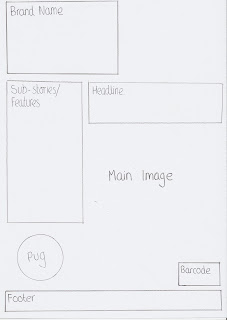
This design follows typical conventions of a magazine double page spread layout. It's typical because it is divided into the two pages, both being given their own specific use. The right hand page has the title at the top, and then three columns of information as well as a pull out quote. Where as the left hand page is purely for images. This design is commonly used for double page spreads, which is why I have decided to not use this design for my double page spread. I decided on this due to the fact I want my magazine to stand out from the crowd and not follow what the other magazines do.
This design is very original, yet it does show some similarities to other double page spreads I have seen in the past. The pages have been flipped over, when in relation to the design above. The article and title will be on the left hand page, where as the image will be on the right hand page, leaving me with a good opportunity to place a big eye catching image there to draw in the reader's attention. This will work quite nicely because when people open a book, magazine or comic, their eyes are usually automatically drawn to the left hand page. I have decided that I am going to use this design for my double page spread because it is original, funky and I believe it will appeal to my audience. Also, I can use the large amount of space available on the left hand side to use a big picture.
This design is another conventional layout that is often used for a double page spread. This is because some magazines like to write bigger articles, which is why the columns carry on underneath the main image. In this design, different features are not confined to one side or the other. Instead the text and photos merge across the centre fold, so there are a bit of both on each page. However, the downside to this design is that it can look a bit messy if not used in the correct way. Therefore I am not going to be using this design for my double page spread. Due to the fact I don't want to end up with a spread that looks messy or cluttered. Also, this design incorporates two photos, when in fact I only want to use one big photo on my double page spread.











